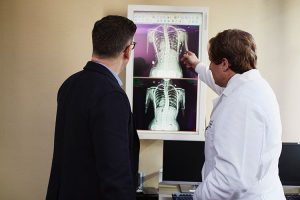The Occupational Safety and Health Administration recently updated its website with new information on how to recognize and control ionizing radiation hazards.
The ionizing radiation webpage features need-to-know information for you to keep your team safe from radiation.
That information includes: Health risks, standards, and prevention methods.
The Risks of Ionizing Radiation
The most common occupational source of radiation is x-ray machinery, so hospitals, medical offices, and dental offices run at high risk.
Recent: Improve Workplace Health & Safety, Increase Your Bottom Line
Radiation effects begin at a cellular level. They cause damage and affect genetic material.
Health problems depend on exposure level from the radiation source, your distance from that source, and the amount of radiation shielding available. And, lasting effects include anything from skin reddening to cancer.
Short- and long-term effects of radiation are unpredictable. Thus, no level of exposure is considered as completely “safe.”
Create a Radiation Protection Program
It’s crucial to fully understand the risks of radiation, and to create an effective health & safety program.
Qualified experts, such as health physicists, also known as a radiation safety officer (RSO), typically manage radiation protection programs.
At a minimum, radiation protection programs should include the following:
- Qualified staff – Provides oversight and responsibility for radiation protection policies and procedures.
- A dosimetry program – Conducts personal exposure monitoring as required by federal or state regulations.
- Surveys and area monitoring – Document radiation levels, contamination with radioactive materials, and potential worker exposures.
- Hazard controls – This includes entry and exit controls, receiving, inventory control, storage, and disposal.
- Worker training – Educate workers on radiation protection, including health effects associated with ionizing radiation dose, and radiation protection procedures and controls to minimize dose and prevent contamination.
- Emergency procedures – Prepare systems that can identify and respond to emergency radiological situations.
- Recordkeeping and reporting programs – Employers should maintain all records and provide reports and notifications as required by regulations. They should also establish an internal audit procedure to annually evaluate all aspects of the program.
“As Low As Reasonably Achievable”
The guiding principle of radiation protection is known as ALARA – As Low As Reasonably Achievable.
Recent: How to Protect Your Team from Silica
ALARA means that employers should seek to eliminate any and all radiation doses that have no direct benefit to the job.
On-Site Medical Surveillance
Maintaining a healthy workforce is easier with regular on-site medical testing. Here at Worksite Medical, we bring all the resources of a medical lab directly to you.
If you’re not sure which tests are required for your workplace, use our OSHA Medical Testing Wizard to find out.
Schedule your visit now, or request a free quote by completing the form below. Or, you can call us at 1-844-622-8633.
Convenient, Compliant Occupational Medicine. Worksite Medical – Let Us Come to You!




